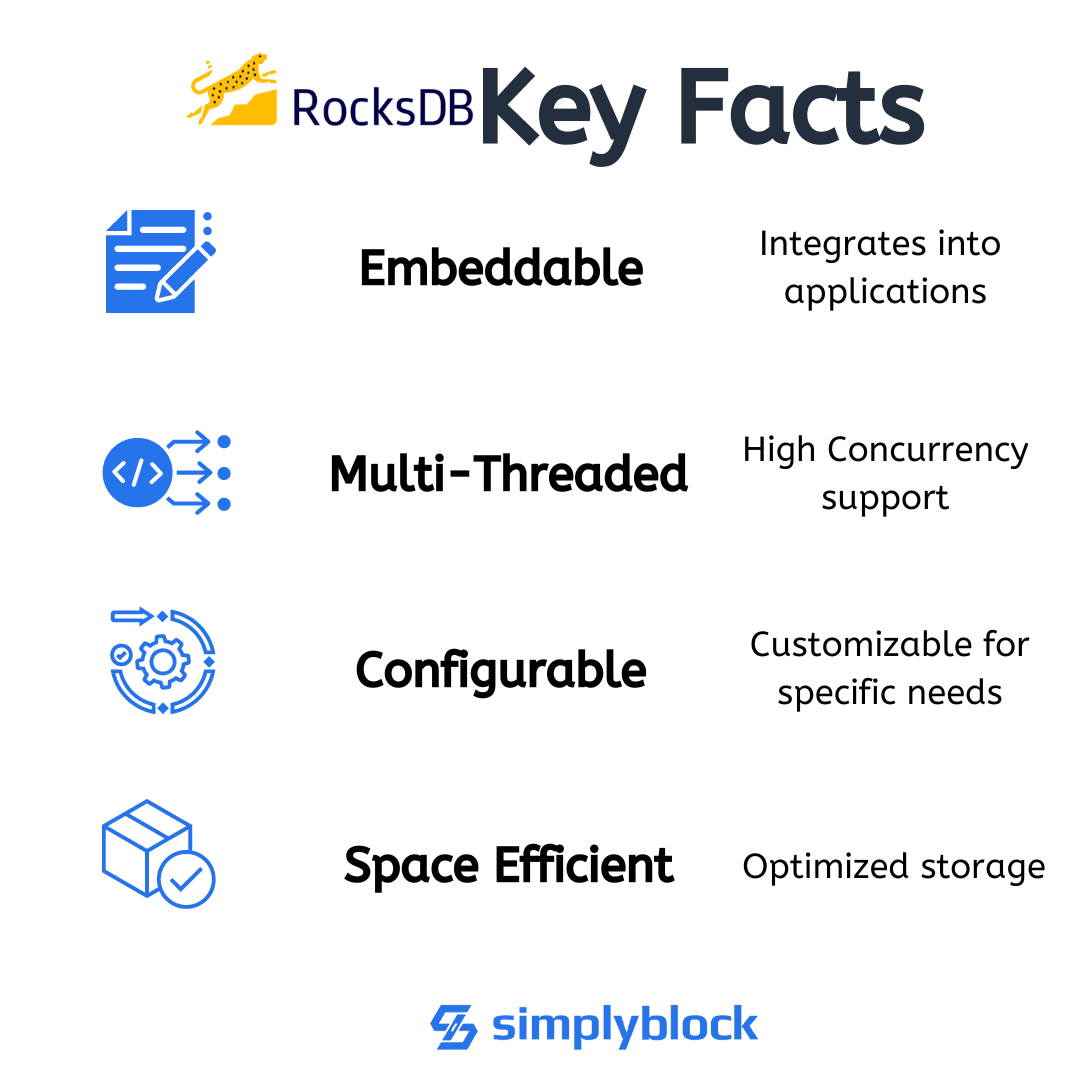RocksDB
Terms related to simplyblock
RocksDB is an embedded, high-performance key-value database developed by Facebook, designed to run on flash, SSD, and NVMe storage. It is built on top of Google’s LevelDB and optimized for fast persistent storage using Log-Structured Merge Trees (LSM Trees). RocksDB is often used as a storage engine for systems that need low-latency access to large volumes of data with frequent updates, including databases, message brokers, and AI inference layers.
Traditional client-server databases run as separate services; by contrast, RocksDB embeds directly within applications, making it a strong fit for high-performance, resource-efficient, and latency-sensitive workloads.
Key Features of RocksDB
RocksDB is purpose-built for applications that demand low-latency read and write operations on local disk. Its primary features include:
- Log-Structured Merge Tree (LSM Tree): Optimized for write-intensive workloads with fast ingestion.
- Embedded Architecture: Runs within the application process, with no network I/O or client-server overhead.
- Write-Ahead Logging (WAL): Ensures durability by logging updates before flushing to disk.
- Column Families: Enables logical separation of data within a single database.
- Compaction Control: Background compaction merges and reclaims disk space to optimize read performance.
- Compression Support: Integrated with ZSTD, LZ4, and Snappy for reducing disk footprint.
- Pluggable Interfaces: Custom comparators, compaction filters, and file systems can be configured.
RocksDB is highly configurable and performance-tuned for NVMe-class block storage, making it a strong match for modern SDS environments like simplyblock™.

RocksDB vs Other Key-Value Stores
RocksDB is often chosen for write-heavy workloads and embedded deployment scenarios. Here’s how it compares:
| Feature | RocksDB | LevelDB | Redis | LMDB |
|---|---|---|---|---|
| Storage Model | LSM Tree | LSM Tree | In-memory | B+ Tree |
| Persistence | Yes | Yes | Optional (AOF/RDB) | Yes |
| Embedded Deployment | Yes | Yes | No | Yes |
| Compression | ZSTD, LZ4, Snappy | Snappy only | No | No |
| Customization | High | Low | Medium | Low |
| Use Case Fit | SSD/NVMe, write-heavy | Light workloads | Real-time caching | Read-heavy |
RocksDB stands out for storage-intensive use cases that require fast local persistence and fine-grained control over compaction and tuning parameters.
Common Use Cases for RocksDB
RocksDB is embedded into applications where tight control over latency and durability is required. Popular use cases include:
- Streaming Engines: Backend for state management in Kafka Streams and Flink.
- Metadata Indexing: Fast lookup tables in filesystems or object storage layers.
- Time-Series and Log Storage: Storing and indexing logs or metrics with high ingest rates.
- AI Model Serving: Caching feature vectors and embeddings at inference time.
- Blockchain and Ledger Systems: Recording transactional state and chain metadata.
For persistent deployment in performance-critical environments, pairing RocksDB with NVMe over TCP-enabled block storage from simplyblock ensures:
- Consistent IOPS for background compaction and WAL flush
- Reduced storage amplification via erasure coding
- Thin provisioning for space efficiency
- Durable, low-latency backups with fast snapshot support
Performance and Storage Considerations
RocksDB performance is deeply tied to I/O efficiency and disk latency. Key factors include:
- Write Amplification: Mitigated with tuned compaction and compression.
- Read Path Latency: Reduced with Bloom filters, block cache, and optimized SST files.
- WAL Throughput: Requires low-latency persistent storage for durability without slowing writes.
- Compaction Overhead: Background jobs can cause IOPS spikes without isolated storage paths.
Running RocksDB on simplyblock’s™ NVMe-backed SDS delivers:
- <1ms latency for flush and compaction
- Predictable performance under high concurrency
- Seamless integration into Kubernetes with CSI volumes
- Resilience via multi-node distributed storage architecture
RocksDB in Kubernetes and Containerized Environments
Though RocksDB is embedded, it often runs inside containers for microservices and AI workloads. In these setups, persistent volumes must handle high IOPS and write throughput.
Using simplyblock for Kubernetes allows RocksDB-based apps to:
- Dynamically provision NVMe-class volumes via CSI
- Persist local state across restarts
- Run on disaggregated infrastructure with full data protection
- Manage multiple tenants via QoS policies
For edge computing or hybrid cloud, simplyblock ensures RocksDB retains the performance of local NVMe while gaining distributed durability and operational flexibility.
External References
Questions and Answers
RocksDB is a high-performance embedded key-value store optimized for fast storage like SSDs and NVMe. Built by Facebook, it’s widely used in databases, stream processing systems, and AI pipelines where low-latency, write-intensive workloads are critical.
Yes, RocksDB can be used inside Kubernetes pods as part of stateful applications like databases or stream processors. For maximum performance and data durability, use Kubernetes-native NVMe storage that offers low latency and persistent volumes.
RocksDB thrives on fast, block-level storage. NVMe over TCP ensures high throughput and IOPS, helping to reduce compaction time and improve tail latency for read/write-heavy applications like LSM-tree-based stores.
RocksDB includes support for encryption via file-based or block-based mechanisms. For stronger multi-tenant and enterprise-grade security, pair it with storage-layer encryption to enforce isolation and regulatory compliance.
Yes, RocksDB is commonly used in stream processing frameworks like Apache Flink and Kafka Streams. Its low-latency and compaction-optimized architecture makes it ideal for AI/ML workloads that require fast ingestion and stateful real-time processing with high-performance storage.
